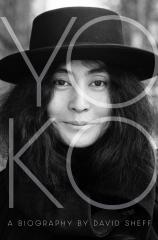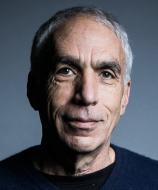Excerpt
Excerpt
Yoko: A Biography

PROLOGUE
Cut Piece
ON THE EVENING OF MARCH 21, 1965, New York’s Carnegie Recital Hall was packed. The audience had gathered for a concert by the artist Yoko Ono, a rising star in the international avant-garde art and music scene.
Yoko walked onto the stage and sat in seiza posture, her legs folded beneath her body. Seiza —“proper sitting”—is the formal sitting position in Japan. It indicates deference.
Yoko was thirty-two years old, with long black hair parted on the side and tied back in a low bun. She was dressed all in black. Besides the artist, the stage was empty except for a pair of scissors on the floor in front of her.
Yoko was performing a work called “Cut Piece.” The audience was invited to come onto the stage one at a time and cut off a piece of her clothing. People were at first diffident and polite when they approached Yoko and wielded the scissors. They trimmed material from the sleeve, neckline, and hem of her sweater and skirt.
But according to artist and filmmaker Eleanor Antin, who was in attendance, “The atmosphere changed to dark and unpleasant when several young men… started taking off large parts of her skirt and sweater, disclosing her bra, and getting back in line after each of their cuts. They couldn’t stop laughing. I recall [the artist] Carolee Schneemann going up to one of them and slapping him in the face, which didn’t faze him one bit. He was after Yoko—the offered sacrifice.”
A man approached and stood over Yoko, mulling where to cut. “It’s very delicate,” he said. “It might take some time.” After cutting away her slip and exposing her bra, he cut the bra straps. Someone in the audience remarked, “He’s getting carried away.” A woman called out, “For God’s sake, stop being such a creep!” There was trepidation in Yoko’s eyes.
Antin recalled, “Yoko made a slight gesture towards the wings, and the curtain immediately closed on her before her breast could be revealed. The piece was over.”
AT THE DEBUT PERFORMANCE OF “Cut Piece,” in Kyoto in 1964, a man mimed stabbing Yoko. The year after the New York performance, she presented it in London, where a group of predatory men rushed the stage and, within minutes, cut off her dress, then her underclothes, leaving her naked.
Schneemann later remarked, “It was an extremely dangerous piece, especially in the moment when it was done, because there was no sense of feminist presence or barriers.… Vile things were in the air then, so she was challenging those very dark impulses in this vulnerable position—and that was the indelible power of it.”
In 2020, more than half a century after “Cut Piece” was first performed, the New York Times identified it as “one of the twenty-five most influential works of American protest art since World War II.”
LIKE “CUT PIECE,” THE SCORES for many of Yoko’s works took the form of poetic instructions for actions and events. Sometimes she executed them herself, but the instructions for her “unfinished” works could be completed by anyone, and some, like “Cut Piece,” required the participation of the viewer or listener. Inviting the audience to join in making a work of art challenged the very idea of what art was. At that time, almost every artist in every medium presented finished work, whether images, objects, plays, poems, or symphonies, but many of Yoko’s scores asked the audience to complete them by performing physical or mental actions. For “Fly Piece,” with the single-word instruction “Fly,” people could come onto the stage and “fly” by jumping off ladders—or they could fly in their minds. For “Whisper Piece,” a work about the fragility of human communication, the audience played the child’s game of telephone. “Bag Piece” instructed participants to get into a cloth bag, in which they could do whatever they wanted—remove their clothes, dance, meditate, take a nap. The meaning, according to Yoko: “All of us are in a bag, you know. The point was the outline of the bag, the movement of the bag: how much we see of a person. Inside there might be a lot going on. Or maybe nothing’s going on.” “Earth Piece,” which Yoko composed in 1963, was a deceptively simple instruction: “Listen to the sound of the Earth turning.” I invite you to try it now. Put down this book and experience an Ono composition: Listen to the sound of the Earth turning.
The artist and musician Laurie Anderson observed, “Yoko had this revolutionary idea that art happens mainly in your head, which is where her work manifests.” And art historian and curator Reiko Tomii said, “She is a conceptual artist who said, ‘You don’t need an object or material to create art.’ Basically, all you need is your mind. You can construct a painting in your head. In your mind, you can create an event.” It was a new concept of what art could be and who could make it.
YOKO CREATED THE FIRST OF her imagination exercises when she was twenty, but their roots go back to her childhood. She was born in Tokyo, a daughter of the Yasuda dynasty. The Yasudas were among the wealthiest, most influential families in Japanese business. As a child, she lived a life of extreme privilege—servants, elite schools, palatial summer and winter homes—until it was interrupted by war.
On the night of March 9, 1945, when Yoko was twelve, the United States dropped 1,665 tons of incendiary bombs on Tokyo. Much of the city was incinerated, and at least one hundred thousand people were killed. Her father was in Hanoi. Her mother and siblings hid in a bomb shelter dug into the garden of their mansion, but Yoko was sick with a fever and couldn’t be moved from her bedroom. She watched the bombs fall—heard the whistling, the explosions; felt the earth shake—and she watched the city burn.
Yoko’s mother decided to evacuate her children to a farming village in Nagano Prefecture, where she bought a small home. It wasn’t fully constructed; the ceiling was unfinished. Money was worthless and food was scarce.
In Nagano, Yoko was with her younger brother, Keisuke (Kei), and she felt responsible for him. “We were starving, my brother looking extremely sad. I remember thinking, ‘Why don’t we make a menu that would really make us feel good?’?” Yoko told Kei, “How about starting with ice cream?” She went on: “Lying on our backs, looking up at the sky through an opening in the roof, we exchanged menus in the air and used our powers of visualization to survive.”
“We made those menus; we imagined the food,” Kei said. “That was my sister’s first conceptual art piece.”
“CUT PIECE” MEANT DIFFERENT THINGS to different people. Many saw it as a feminist work about the vulnerability of women and the violence perpetrated on them.
“Canonized as one of the most chilling, spellbinding works of feminist art to date, ‘Cut Piece’ eloquently conveys an experience familiar to many women—that of being inside a body upon which others feel entitled to act,” according to critic Zoë Lescaze.
However, Yoko refused to be pinned down about the meaning of “Cut Piece.” For her, the work was about anything anyone said it was. That was the point of her unfinished art. She created the pieces and the audience activated them. She gave them away in the moment of performance, relinquishing them as she relinquished her clothing in “Cut Piece.” They became the property of whoever took them, and the new owner could ascribe any meaning (or no meaning).
Still, over time Yoko would also characterize “Cut Piece” as a spiritual act about the power of giving that was inspired by a story about an incarnation of the Buddha who gave away his possessions and became enlightened. At other times she said it was about vulnerability, trust, and a call for peace. Of her experience while performing the piece, she wrote, “I felt kind of like I was praying. I also felt that I was willingly sacrificing myself.” Once she said, “When I do the ‘Cut Piece,’ I get into a trance, and so I don’t feel too frightened.” But she admitted that despite her defiant stoicism, sometimes her body shook. The audience couldn’t tell she was afraid; she was adept at internalizing fear and projecting confidence because she’d been doing it since she was a child, in bed, watching through the window as Tokyo burned.
Yoko: A Biography
- Genres: Biography, Nonfiction
- hardcover: 384 pages
- Publisher: Simon & Schuster
- ISBN-10: 1982188243
- ISBN-13: 9781982188245



